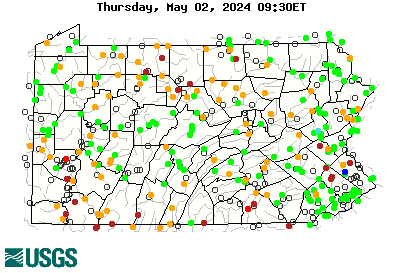Might be of interest- from todays Pittsburgh Post Gazette.
Hall of Fame angler George Douglas focuses on adapting to changing conditions on steelhead waters
Sunday, October 24, 2010
By John Hayes, Pittsburgh Post-Gazette
Kype MagazineSmile for the camera. Fishing guide, outdoor writer and magazine publisher George Douglas with a big brown.Twelvemile Creek is stained and rising the morning after a late-night rain, and your chartreuse Wooly Bugger has hooked up with a dozen active steelheads. It's a great day for fishing.
The following Saturday, the creek is low and gin-clear at the same spot, and you roll hundreds of casts with the same fly with no results. A week later, high chocolate water tears through the same stretch of Twelvemile, and there you stand in the brown water flipping the same Wooly Bugger without a single strike.
There's nothing wrong with the fly, and the fish are acting predictably.
Matching techniques to conditions is perhaps the most important part of steelhead angling, said fishing guide and writer George Douglas. Failure to adapt may be the biggest mistake made by the greatest number of Steelhead Alley anglers.
In his new book, "Fish Like a Guide" (Castle Douglas), the 2010 inductee to the Freshwater Fishing Hall of Fame and publisher of Kype magazine shares some of the cues that help steelhead guides to anticipate water conditions and adapt to changes, ensuring that their clients won't go home empty handed.
"I like to educate anglers and bring some awareness of alternate techniques," Douglas said in a recent telephone interview. "Guys go out and have a big day with indicator-nymph fishing and will continue fishing that way for years. I like to help them to not get set in their ways. Some days indicators are the technique, but other times its tight-line fishing or swinging from a spey rod or centerpin fishing. We promote all techniques."
A Washington-state native, Douglas has "kind of made camp" in Ohio to be closer to the Lake Erie steelhead runs. He has visited Pennsylvania several times in the last month promoting "Fish Like a Guide" and an updated reprint of "The Complete Guide to the Salmon River" (Outdoor Productions), his seminal book about fishing the famous New York waters. At 7:30 p.m. Tuesday Douglas will speak at a meeting of Pittsburgh Downriggers at the Coraopolis Sportsmen Association (106 Coketown Rd., Coraopolis, 412-264-9920, www.pittsburghdownriggersclub.com). The meeting is free and open to the public.
Douglas said his talk will focus on "the mindset of a guide."
"Guides have a sense of urgency to catch fish. The first priority is to avoid getting skunked," he said. "What I try to do is get [the client's] first fish in early. After that I can relax and work toward having that big day on the river."Organization of tackle, quick knot tying and knowing how to bring a fish back against a strong current are important, he said. But the greatest service provided by a good guide is the ability to anticipate conditions and adapt to real-time changes on the water.
"Basically what I try to do is not rely on the chat forums for calling the shots. When you resort to that it's the same story, 'You should have been here yesterday,' " he said. "I look at water level charts and weather patterns, as well as the forums, and try to get familiar with the fishery. I tried to put forth a formula in the book to help people to anticipate runs so they'll be there on the day it's happening."
On big West Coast waters, for example, Douglas checks the weather charts to anticipate the inland arrival of big storms. Understanding their influence on glacial melt, he makes plans to get clients on the water three days after the rain to take advantage of receding flows and the best runs.
"It's different on Lake Erie tribs," he said. "You want to fish it on the rise."
Steelhead strategy for Pittsburghers often comes down to knowing when to gas up and drive to Erie, and when to stay home. Knowledge of varying drainage rates on smaller creeks east of the peninsula and the mostly bigger waters to the west can help anglers to be at the right place at the right time.
"Being two or three hours out, I'd probably check back in the fishing reports and see how many days after a good rain the fishing was good on certain streams," he said. "Then I'd see what the [cubic feet per second] was on that successful day, and cross reference. That would help me predict where to be and when to be there in the future."
Douglas said anglers in the I-79 corridor south of Erie are fortunate to live relatively close to "a world-class fishery."
"This is a really special place. When I'm speaking in Ohio and Pennsylvania, I try to express how lucky they are to be within driving distance to a fishery of that status," he said. "On the West Coast, fishing the Skagit River and other places, you're hoping for one or two good fish a day. Here, the whole Steelhead Alley region from Cleveland to Buffalo is phenomenal. Whether it's the Pennsylvania strain or the Little Manistee strain in Ohio, the number of fish is incredible."
The Pennsylvania steelies tend to be a little more slender, he said, "but there are tons of them. Really."
Read more: http://www.post-gazette.com/pg/10297/1097638-358.stm#ixzz13HuT8oy0






